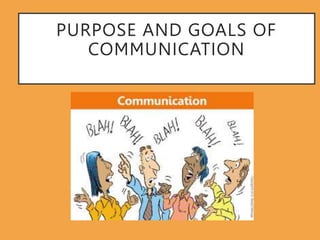
Goals and Types of Communication
- 1. PURPOSE AND GOALS OF COMMUNICATION
- 2. OBJECTIVES 1. 1. Definition Of Communication 2. 2. Function of Communication 3. 3. Purpose of Communication 4. 4. Types of Communication
- 3. DEFINITION FOR COMMUNICATION •The establishment of a commonness or sharing of information, ideas, and understanding with receivers •The process of transmitting and receiving verbal and non verbal messages that produce a response
- 4. FUNCTION OF COMMUNICATION •To provide information •To give command/instruction •To influence or persuade •To integrate and unite
- 5. DEFINITION FOR HUMAN COMMUNICATION A dynamic process of creating meaning between two or more people
- 6. THE COMMUNICATION PROCESSS MODEL central thought process linguistic encoder central thought process linguistic encoder Transmission through a channel Sender’s context Receiver’s context nois e Feedbac k though t signal received acoustic signal receive d thought 1.The encoder (sender) initiates the communication by creating a message. 2. Message is sent to the decoder (receiver) through a communication channel. 3. The receiver responds to the message through the use of feedback. 4. Transactions can be initiated by sender and receiver.
- 7. MAIN ELEMENTS IN HUMAN COMMUNICATION • 1. Sender (encoder) • 2. Receiver (decoder) • 3. Input/message • 4. Channel • 5. Feedback • 6. Noise
- 8. CHANNEL
- 9. CLASSIFICATION OF CHANNELS In choosing your channel, analyse your receiver in 4 areas: • Knowledge • interests, • attitudes, • emotional state
- 11. 4 AREAS WHEN ANALYZING RECEIVER • 1. Knowledge: How much does receiver know about discussion • 2. Interest: Is receiver interested in topic • 3. Attitudes: How is receiver likely to react to my message • 4. Emotional states: Is receiver in right frame of mind
- 12. FEEDBACK
- 13. FEEDBACK • Provide feedback to sender • Indicate to sender if message is understood • Sender (of message) should directly or indirectly ask for response • Ask precise questions or make clear statement
- 14. PURPOSE OF COMMUNICATION • 1. Gain receiver understanding • 2. Obtain constructive response from receiver • 3. Development and maintenance of good relationship
- 15. GOALS OF COMMUNICATION GOAL 1: Facilitate receiver understanding -both sender and receiver share the same meaning or idea
- 16. GOALS OF COMMUNICATION GOAL 2: Obtain a constructive response - positive / negative - can be in the form of words, signals or actions Thus, a receiver may provide: • a verbal response • a signal • an action
- 17. GOALS OF COMMUNICATION GOAL 3: Develop and maintain good relationship
- 18. TUTORIAL SESSION
- 19. GROUP ACTIVITY: CHINESE WHISPER • 1. Please stand in a line next to each other. • 2. You will receive instruction of convey a message with your group members. • 3. The final recipient of the message must speak and act out the message that has been received.
- 21. BARRIERS TO EFFECTIVE VERBAL COMMUNICATION COMMUNICATION SITUATIONS HAVE BARRIERS (ALSO CALLED AS NOISE OR INTERFERENCE).
- 22. COMMUNICATION BARRIERS (INTERFERENCES) Involves: • the sender & the receiver • message and channel
- 23. BARRIERS TO VERBAL COMMUNICATION
- 25. PROCESSES INVOLVED IN BARRIERS: • 1. Encoding barriers • 2. Decoding barriers • 3. Transmitting barriers • 4. Responding barriers
- 26. ENCODING BARRIERS Breakdown will happen if sender: Fails to recognize receiver’s needs, status, knowledge and skills Encodes message using bad grammar or appropriate language Provides too much or too little information Is emotionally disturbed while formulating message
- 27. DECODING BARRIERS Communication may be unsuccessful if the receiver : Has inadequate language proficiency Is not in proper mental stage to receiving message
- 28. TRANSMITTING BARRIERS The receiver may find the message difficult to understand if: There are distractions such as noise Wrong choice of channel is made
- 29. RESPONDING BARRIERS Communication is unsuccessful is no appropriate feedback is received.
- 30. VERBAL OR FACE TO FACE COMMUNICATION • More effective with immediate feedback • Comes as public address, discussions, meetings, conferences, lecturers • Involves transmission of information from speaker to listener
- 33. INTERPERSONAL & INTRAPERSONAL COMMUNICATION 1. Intrapersonal Communication Our innermost thoughts and self-conversations. Private unless we share them verbally to others. 2. Interpersonal Communication Communication between two individuals. Roles of sender and receiver is swapped continuously.
- 34. SMALL GROUP & PUBLIC COMMUNICATION 3. Small group Communication Communication amongst a small group of individuals. Number of participants should be small enough to allow for all participants to converse comfortably. Requires a specific agenda to be discussed or it can be chaotic and difficult to follow. Potentially needs good leadership to guide the conversation and discussion flow. 4.Public Communication Communication between an individual speaker and a large group. Generally, a one-way type of communication.
- 35. VERBAL COMMUNICATION • Intrapersonal: • Interpersonal: • Small Group Communication • Public Communication
- 37. VISUAL COMMUNICATION Use of images and visual effects to convey information and ideas Use of icons and emoticons Use print models (3D) to ilustrate drawing or sketches Use in presentations and emails
- 38. WHY DOES VISUAL COMMUNICATION MATTER It saves time by relating messages faster Ensures clear, unified message Results in better retention of information
- 39. NON VERBAL COMMUNICATION • Facial expressions • Eye contact • Body posture and position • Gestures • Para linguistics
- 40. PARA- LINGUISTICS Para -linguistic element Meaning Volume Level of voice (loud or soft) Tone Emotions behind the speech (anger, sarcasm, indifference) Speed of voice/Speech flow/Fluency The pace of your speech Intonation/Modulation Rise and fall in your voice (avoid monotony) Articulation Clarity in voice Pronunciation The way a word is pronounced correctly Punctuation Use of pauses as a speech element or style.
- 41. STRATEGIES FOR EFFECTIVE VERBAL COMMUNICATION • Focus on communicative issues, not sender/receiver • BE genuine • BE empathetic • BE flexible towards others • Value yourself and your own experiences
- 42. ANY QUESTIONS?